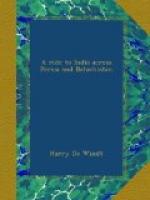The original scheme was a bold one, and I derive some consolation in the thought that the journey would most probably have ended in defeat. This was the idea. From Tiflis to Baku, and across the Caspian to Ouzoun Ada, the western terminus of the Trans-Caspian Railway. Thence by rail to Merv and Bokhara, and from the latter city direct to India, via Balkh and Cabul, Afghanistan. A more interesting journey can scarcely be conceived, but Fate and the Russian Government decreed that it was not to be. Not only was I forbidden to use the railway, but (notwithstanding the highest recommendation from the Russian Ambassador in London) even to set foot in Trans-Caspia.
The old adage, “delay is dangerous,” is never so true as when applied to travel. The evening of my interview with the governor, I had resolved, ere retiring to rest, to make for India via Teheran. My route beyond that city was, perforce, left to chance, and the information I hoped to gain in the Shah’s capital.
Tiflis, capital of the Caucasus, is about midway between the Black and Caspian seas, and lies in a valley between two ranges of low but precipitous hills. The river Kur, a narrow but swift and picturesque stream spanned by three bridges, bisects the city, which is divided in three parts: the Russian town, European colony, and Asiatic quarter. The population of over a hundred thousand is indeed a mixed one. Although Georgians form its bulk, Persia contributes nearly a quarter, the rest being composed of Russians, Germans, French, Armenians, Greeks, Tartars, Circassians, Jews, Turks, and Heaven knows what besides. [B]
Tiflis is a city of contrasts. The principal boulevard, with its handsome stone buildings and shops, tramways, gay cafes, and electric light, would compare favourably with the Nevski Prospect in St. Petersburg, or almost any first-class European thoroughfare; and yet, almost within a stone’s throw, is the Asiatic quarter, where the traveller is apparently as far removed from Western civilization as in the most remote part of Persia or Turkestan. The Armenian and Persian bazaars are perhaps the most interesting, I doubt whether the streets of Yezd or Bokhara present so strange and picturesque a sight, such vivid effects of movement and colour. Every race, every nationality, is represented, from the stalwart, ruddy-faced Russian soldier in flat white cap and olive-green tunic, to the grave, stately Arab merchant with huge turban and white draperies, fresh from Bagdad or Bussorah. Georgians and Circassians in scarlet tunics and silver cartridge-belts, Turks in fez and frock-coat, Greeks and Albanians in snowy petticoats and black gaiters, Khivans in furs and quaint conical lamb’s-wool hats, Tartars from the Steppes, Turkomans from Merv, Parsees from Bombay, African negroes,—all may be seen in the Tiflis Bazaar during the busy part of the day.
But woe to the luckless European who, tempted by the beauty of their wares, has dealings with the wily Persian merchant. There is a proverb in Tiflis that “It takes two Jews to rob an Armenian, two Armenians to rob a Persian,” and the “accursed Faringi” is mercilessly swindled whenever he ventures upon a bargain.




